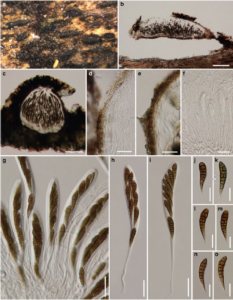Brunneoclavispora bambusae Phookamsak & K.D.Hyde.
Index Fungorum number: IF551327; Facesoffungi number: FoF00893; Fig. 1
Etymology – The specific epithet “bambusae” refers to the host.
Holotype – MFLU 11-0213
Saprobic on bamboo. Sexual morph: Ascomata 220 – 330 μm high, 800 – 1100 μm diam., solitary to gregarious, immersed in pseudoclypeus, visible as raised darkened, elongate areas on host surface, uni-loculate, elongate conical with a flattened base, glabrous, ostiole central, with slit-like opening. Peridium 7 – 18.5 μm wide, of unequal thickness, slightly thick at the sides, composed of several layers of pseudoparenchymatous cells, outer layers comprising several layers of brown to dark brown cells, arranged in textura angularis to textura prismatica, inner layers comprising several layers of flattened, hyaline cells, arranged in textura prismatica to t.porrecta. Hamathecium composed of dense, 1 – 2.5 μm wide, cellular pseudoparaphyses, indistinctly septate, not constricted at the septum, anastomosing at the apex, embedded in a mucilagenous matrix. Asci (120–) 130 – 170 (−185) × (12–) 13 – 15 (−16) μm (x̄ = 147 × 13.9 μm, n = 25), 8 – spored, bitunicate, fissitunicate, clavate, short to long pedicellate, apically rounded, with well-developed ocular chamber. Ascospores (23–) 25 – 28 (−30) × 5 – 7 μm (x̄ = 26.4 × 5.8 μm, n = 30), overlapping uni – to bi – seriate, brown to dark brown, clavate or fusuform, with rounded upper part and tapering lower part, straight or slightly curved, with 7–8 transverse septa, and 1 – 4 longitudinal septa, slightly constricted at the septum, deeply constricted at the third septum, the third cell usually large and having longitudinal septa, smooth-walled, with tail-like appendage at lower end (3 – 5 μm long). Asexual morph: Undetermined.
Culture characteristics – Colonies on PDA slow growing, reaching 12 – 18 mm diam. after 4 weeks at 25 – 30 °C, colonies irregular, dense, low convex, dull with undulate edge, velvety, slightly radiating, redially furrowed, colonies from above white to grey (5A1–5E1) at the margin, orange grey to grey-orangish (5B2 – 5B3) in the middle, and light brown to yellowish brown at the centre (5D6–5E6); from below yellowish brown to blackish brown (5 F8 – 6G8), not producing pigment on PDA, but producing dark brown pigment in V8 media and yellowish white to yellowish grey pigment in MEA.
Material examined – THAILAND, Chiang Rai Province, Mae Jun District, Huai Kang Pla Waterfall, on dead stem of bamboo, 25 October 2010, R. Phookamsak RP0093 (MFLU11-0213, holotype), ex-type living culture, MFLUCC 11-0177, BCC.

Fig. 1 Brunneoclavispora bambusae (holotype) a Ascomata visible as raised black oval areas, on host surface b Longitudinal section through an ascoma c Vertical section through an ascoma d, e Section through peridium f Pseudoparaphyses g – i Asci j – o Ascospores. Scale bars: b = 200 μm, c = 100 μm, d – i, m = 20 μm, j – o = 10 μm.
